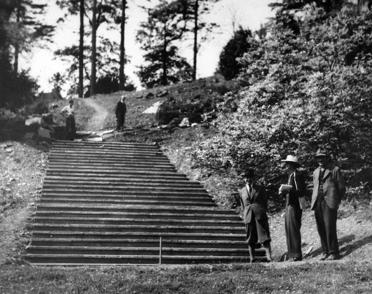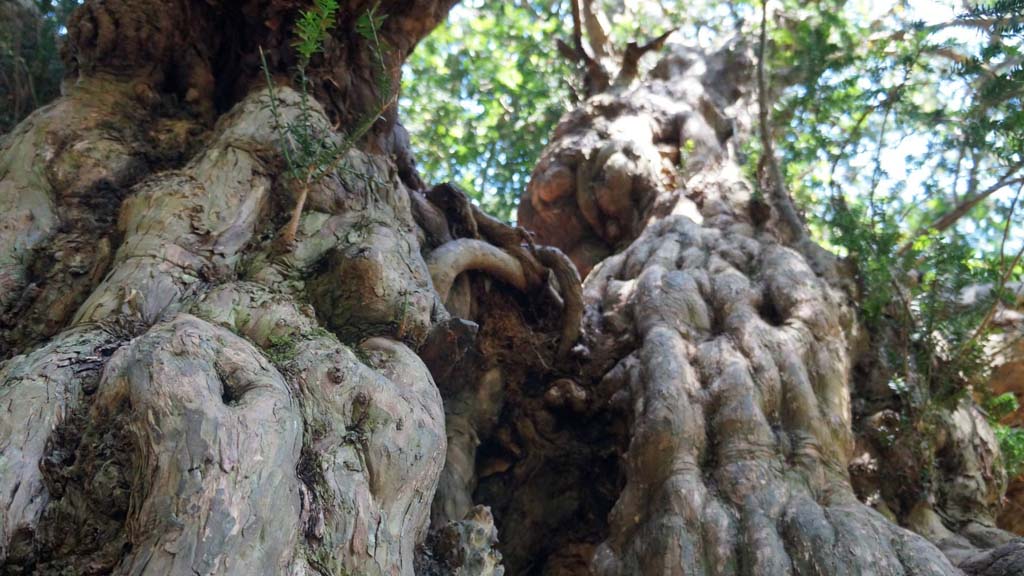I’ve completed a 50-page research project mapping the history of Dartington’s formal gardens. It aims to inform current management of the gardens because (to borrow a phrase from TV gardener Monty Don) ‘in order to move forward we need to understand what went before’.
The history covers the period of owners from 900AD to the present, and details the work of garden designers and sculptors who make the garden what it is today.

One such was garden designer Percy Cane, appointed by Dorothy and Leonard Elmhirst in the 1950s, who installed a number of vistas that aimed to connect the garden with the landscape beyond, as well as strengthen links between areas in the garden.
As Dorothy Elmhirst said in 1963: “The whole place was shut in. We had to discover a thread of relationship that could tie the immediate intimacy to the distant aspect in a natural harmonious manner.”
The main vista is from the Temple (building with white stone seat) down a glade to the rolling Devon hills.
Another is from the west of our Great Lawn down past the wooden Summer House to Totnes Church spire. And a third currently lost among trees but one we’d like to reopen when funds allow, is from the ‘Whispering Circle’ which Reginald Snell said in 1989 “gives a wonderful view over miles of Devon countryside to the south east”.
I also documented our ancient yew, profoundly worthy of that name at 1,500 to 2,000 years old, which is situated in the graveyard of St Mary’s church tower. I’ve uncovered theories as to its origin and survival and I’d love it if any historians are able to confirm them.

My research found that Yew trees were planted as winter meeting places in the UK at a time when yew, box and juniper were the only native evergreens. A church was built around it. The rest of the yew tree population was obliterated to produce longbows, but this specimen was protected as it was on religious ground.
If you’ve any thoughts or information on this, please do get in touch with me via info@dartington.org.
Katy Ross (previously gardener at Dartington Hall)

Nice Blog!! The content you have shared is very elaborative and informative. Thanks a lot for sharing such a great piece of knowledge with us.
Hi Kathy,
Let us take a moment and appreciate your efforts for maintaining the Dartington’s formal garden all these years. I am curious to know about your 50-page research project mapping the history of Dartington’s formal gardens.
Thank You,
Marcus Alonso
Hi Marcus, thanks for your comment. Katherine is on leave at the moment but we know she will really appreciate the kinds words. Regarding the 50-page project, Katherine has since published another blog with more detail, and you can also download the entire report. Click here to read this.
Hello we visited your beautiful gardens last week and are mystified by a very scented tree near the walkway by the tilt yard. It has small leaves and creamy white flowers that hang like bells until they open to look like stars. They have 4 petals. Please could you let me know. It was also around by the donkey statue area too. Thanks.
Hi Fiona, from your description I am almost sure Elaeagnus umbellate is the plant – although I haven’t seen it near the donkey. Does this help?
All the best
Katherine
Many thanks – much appreciated. We love it! Fiona
Hi Katie,
I wonder if it’s possible to obtain a copy of your 50-page research project. I am very interested in the history of the gardens, and seeking information for a performance / poetry project about the gardens.
Hi Jaime, thank you for getting in touch.
Yes, of course. You can download it here.
All the best
Katherine
FAO Katherine Ross – Tree species queery
Hi Katherine,
I’ve been trying to identify the type of tree by the Peter Randall bridge, which looks similar to lychee.
It’s a delight in winter. Can you satisfy my curiousity? Thankyou.
Best regards,
Karen Benson
Hi Karen,
Apologies for the delay responding to your comment.
The tree is a Cornus capitata, or headed-flowered dogwood. The fruits are often described as ‘strawberry-like’ and ripen around November time. The fruit is edible and apparently tastes of over ripe banana, I haven’t tried them myself…Martin Crawford has a specimen in his Forest Garden down the road.
The flower is wonderful, it is evergreen and has an attractive fruit in the winter. It certainly works hard for its prime spot on the sunny border, by the bridge.
Hope to hear from you again and this was helpful All the best Katherine